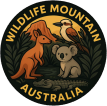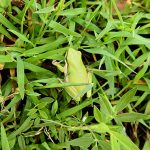EASTERN DWARF TREE FROG
Eastern Dwarf Tree Frog
The Eastern Dwarf Tree Frog is one of Australia’s tiny jewels of the wetlands – bright, agile, and often heard long before it is seen. Despite its small size, it plays a surprisingly big role in the soundscape and ecology of eastern Australia.
Quick Facts
| Feature | Detail |
|---|---|
| Scientific name | Litoria fallax |
| Common name | Eastern Dwarf Tree Frog |
| Family | Hylidae (tree frogs) |
| Size | About 20–25 mm (2–2.5 cm) |
| Distribution | Eastern Australia (QLD to north-eastern NSW) |
| Habitat | Wetlands, ponds, dams, swamps, urban gardens |
| Activity | Mostly nocturnal |
| Conservation status | Not currently threatened (locally common) |
Appearance
Imagine a frog no bigger than the nail on your thumb, with colours like fresh leaves after rain.
Key features:
- Size: Very small, usually 2–2.5 cm in length
- Colour:
- Back: bright green, olive, or sometimes brownish
- Often with a golden or bronze stripe running from the nostril, through the eye, along the body
- Sides: Pale cream or yellowish on the belly
- Skin: Smooth, slightly moist
- Legs and toes:
- Long, slender limbs
- Toes with small round toe pads that help it climb reeds and vegetation
- Eyes: Prominent, with horizontal pupils
Their colouring helps them blend perfectly into reeds, grasses, and aquatic plants, which is why people usually hear them before they manage to spot them.
Distribution and Habitat
Where they live
The Eastern Dwarf Tree Frog is found along the eastern coast of Australia, mainly:
- Eastern Queensland
- North-eastern New South Wales
- Often near the coast and lower altitude areas
Preferred habitats
They are strongly associated with still or slow-moving freshwater, such as:
- Swamps and marshes
- Farm dams and drainage ditches
- Ponds and lakes
- Garden ponds and ornamental water features
- Flooded grasslands and roadside wetlands
They spend much of their time:
- Perched on reeds, sedges, and grasses
- Near the water’s edge where they can quickly retreat if threatened
Their ability to live in human-modified environments (like suburban gardens with ponds) is one reason they are still relatively common.
Behaviour and Lifestyle
Mostly nocturnal:
- During the day they often rest quietly among vegetation, relying on their camouflage.
- At night they become more active, calling, feeding and moving between plants.
Arboreal tendency:
- Despite being tiny, they are skilled climbers and often sit on stems and leaves above the water.
The chorus at night
On warm, humid nights – especially after rain – they join in large choruses.
- Males gather around water and call to attract females.
- The combined calls can form a strong, buzzing, tinkling chorus around wetlands.
Call
The call is one of the easiest ways to detect them.
- Often described as a rapid, high-pitched “chik… chik… chik” or “tik-tik-tik”
- Repeated quickly, sometimes in long sequences
- Males call from reeds and grasses, often just above the water surface
In a healthy wetland, many males call together, creating a layered, almost musical background sound, especially on summer nights.
Diet and Role in the Ecosystem
What they eat
Eastern Dwarf Tree Frogs are small but active predators of invertebrates:
- Mosquitoes and other small flying insects
- Ants, small beetles, moths, and midges
- Tiny spiders and other arthropods
They typically wait on vegetation and snap at passing prey with quick flicks of the tongue.
Their ecological role
- Insect control: They help keep insect populations, including mosquitoes, in check.
- Food source:
- Tadpoles are eaten by fish, aquatic insects, and larger tadpoles
- Adult frogs are prey for birds, snakes, larger frogs, and some mammals
- Bioindicators: Frogs are sensitive to pollution and habitat changes. Their presence can indicate relatively healthy aquatic environments.
Life Cycle
Like most frogs, Litoria fallax has a two-stage life cycle: aquatic tadpole and terrestrial adult.
1. Breeding
- Breeding is often triggered by rain, warm temperatures, and rising water levels.
- Males call from vegetation around water to attract females.
- Once a female chooses a male, they pair up in a position called
amplexus(the male holding onto the female) and eggs are laid in the water.
2. Eggs
- Eggs are small and usually laid in clumps in still or gently flowing water.
- They float or attach to submerged vegetation.
- Eggs hatch in a few days, depending on temperature.
3. Tadpoles
- Tadpoles are aquatic, with long tails and gills.
- They graze on algae, decaying plant material, and microscopic organisms.
- Development time can vary (weeks to a few months), influenced by temperature, food, and water conditions.
4. Metamorphosis
- As they develop, tadpoles form:
- Hind legs, then front legs
- Lungs, while gills are reduced
- A shrinking tail
- They eventually become tiny froglets only a few millimetres long, often still close to the water’s edge.
Conservation Status
At present, the Eastern Dwarf Tree Frog is not listed as threatened and is considered quite common in many parts of its range.
However, like many frogs globally, it still faces pressures:
- Habitat loss: Draining of wetlands, development, and land clearing.
- Water pollution: Chemicals, fertilisers, and runoff can affect eggs and tadpoles.
- Introduced fish: Species such as Mosquitofish (Gambusia) prey on eggs and tadpoles.
- Climate change: Changes to rainfall patterns and increased frequency of droughts can reduce breeding opportunities.
Their continuing presence in suburban and rural areas is encouraging, but it depends on the ongoing availability of clean water and suitable vegetation.
How You Can Help Eastern Dwarf Tree Frogs
Even in towns and cities, it is possible to create small pockets of habitat that support frogs.
Frog-friendly actions:
Create or maintain a garden pond
- Use shallow edges and native aquatic plants.
- Avoid fish if possible, as many will eat eggs and tadpoles.
Provide vegetation around water
- Reeds, sedges, and grasses give frogs places to perch, hide, and call from.
Avoid chemicals near water
- Reduce or eliminate pesticides, herbicides, and fertilisers around ponds and drains.
Keep some leaf litter and natural structure
- Logs, rocks and dense garden beds provide shelter for frogs during the day and outside the breeding season.
Protect local wetlands
- Support conservation efforts and community groups working to restore and protect wetlands.
A Night with the Eastern Dwarf Tree Frog
Imagine standing by a small pond on a warm, still evening. The air is thick with the sweet, damp scent of wet soil and decaying leaves. A light mist rises, softening the outlines of reeds along the water’s edge.
At first you hear just a faint, high-pitched ticking – one frog testing its voice. Then another joins, and another, until the edge of the pond seems to vibrate with rapid, chiming calls. The sound is delicate yet insistent, like tiny wooden sticks tapping glass.
You shine a gentle light across the reeds. A small shape appears: a bright green frog, no larger than a coin, clinging to a slender stem. Its skin glistens, and its side stripe catches a hint of bronze under the light. It pauses, throat ballooning out into a pale, round bubble as it calls again, then folds quietly back into the darkness of the plants.
In this small, shimmering world of water and reeds, the Eastern Dwarf Tree Frog is both musician and insect hunter, reminding us how much life can be contained in the narrow margin where land meets water.

